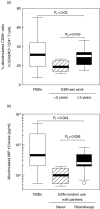Suppressed cellular alloimmune responses in HIV-exposed seronegative female sex workers
- PMID: 16487242
- PMCID: PMC1809613
- DOI: 10.1111/j.1365-2249.2006.03017.x
Suppressed cellular alloimmune responses in HIV-exposed seronegative female sex workers
Abstract
Particular human leucocyte antigen (HLA) polymorphisms have been associated with a reduced risk of HIV transmission. However, protective alloimmune responses expected to result from such a genetic predisposition have not been demonstrated. To this end, we analysed and compared cellular and humoral alloimmune responses in a cohort of female sex workers who remained human immunodeficiency virus (HIV)-seronegative despite more than 3 years of high-risk sexual activity (ESN FSWs) with those of low-risk HIV-seronegative female blood donors in Abidjan, Côte d'Ivoire. ESN FSWs showed significantly lower allostimulated CD69 expression and secretion of interferon-gamma, macrophage inflammatory protein (MIP)-1beta and RANTES (regulated upon activation, normal T-cell expressed and secreted) by lymphocytes than controls. In contrast, ESN FSWs showed significantly higher mitogen-stimulated CD69 expression and secretion of tumour necrosis factor-alpha and MIP-1beta than controls. Suppression of cellular alloimmune responses among ESN FSWs was associated with a higher self-reported frequency of unprotected sex. Levels of anti-HLA class I alloantibodies in plasma were not significantly different between ESN FSWs and controls. These findings indicate that frequent sexual exposure to multiple partners results in suppression rather than activation of cellular alloimmune responses. Our data support the hypothesis that suppressed cellular alloimmune responses may play a role in protection against HIV infection.
Figures

 ) and class II (HLA-DR)(▪) expression on T-cells after inactivation with PFA, MMC and AMD. (c) CD69 membrane expression on T-cells after inactivation with PFA, MMC or AMD and stimulation with PMA/ionomycin (in the absence of brefeldin A). (d) Intracellular expression of IFN-γ (
) and class II (HLA-DR)(▪) expression on T-cells after inactivation with PFA, MMC and AMD. (c) CD69 membrane expression on T-cells after inactivation with PFA, MMC or AMD and stimulation with PMA/ionomycin (in the absence of brefeldin A). (d) Intracellular expression of IFN-γ ( ) and IL-4 (▪) in T-cells after inactivation with PFA, MMC or AMD and stimulation with PMA/ionomycin (in the presence of brefeldin A). Data are representative for PBMC from two controls.
) and IL-4 (▪) in T-cells after inactivation with PFA, MMC or AMD and stimulation with PMA/ionomycin (in the presence of brefeldin A). Data are representative for PBMC from two controls.


Similar articles
-
Cellular human immunodeficiency virus (HIV)-protective factors: a comparison of HIV-exposed seronegative female sex workers and female blood donors in Abidjan, Côte d'Ivoire.J Infect Dis. 2003 Jan 15;187(2):206-14. doi: 10.1086/346049. Epub 2002 Dec 30. J Infect Dis. 2003. PMID: 12552445
-
HIV-specific T helper responses and frequency of exposure among HIV-exposed seronegative female sex workers in Abidjan, Cote d'Ivoire.J Infect Dis. 2004 Feb 15;189(4):602-10. doi: 10.1086/381454. Epub 2004 Jan 29. J Infect Dis. 2004. PMID: 14767812
-
The high frequency of HIV type 1-specific cellular immune responses in seronegative individuals with parenteral and/or heterosexual HIV type 1 exposure.AIDS Res Hum Retroviruses. 2012 Dec;28(12):1598-605. doi: 10.1089/aid.2011.0335. Epub 2012 Apr 26. AIDS Res Hum Retroviruses. 2012. PMID: 22475222
-
[Factors involved in resistance to human immunodeficiency virus infection].Med Clin (Barc). 2011 Nov 19;137(13):600-4. doi: 10.1016/j.medcli.2010.11.023. Epub 2011 Mar 5. Med Clin (Barc). 2011. PMID: 21382628 Review. Spanish.
-
Not just sheer luck! Immune correlates of protection against HIV-1 infection.Vaccine. 2008 Jun 6;26(24):3002-7. doi: 10.1016/j.vaccine.2007.11.062. Epub 2007 Dec 18. Vaccine. 2008. PMID: 18180082 Review.
Cited by
-
Blunted IL17/IL22 and pro-inflammatory cytokine responses in the genital tract and blood of HIV-exposed, seronegative female sex workers in Kenya.PLoS One. 2012;7(8):e43670. doi: 10.1371/journal.pone.0043670. Epub 2012 Aug 22. PLoS One. 2012. PMID: 22928014 Free PMC article.
-
Neither microbial translocation nor TLR responsiveness are likely explanations for preexisting immune activation in women who subsequently acquired HIV in CAPRISA 004.J Acquir Immune Defic Syndr. 2013 Jul 1;63(3):294-8. doi: 10.1097/QAI.0b013e31828e604b. J Acquir Immune Defic Syndr. 2013. PMID: 23481666 Free PMC article. Clinical Trial.
-
Evaluation of the lymphocyte trafficking drug FTY720 in vaginal tissues.J Med Primatol. 2013 Apr;42(2):89-100. doi: 10.1111/jmp.12033. Epub 2013 Jan 12. J Med Primatol. 2013. PMID: 23311598 Free PMC article.
-
Can an immune-regulatory vaccine prevent HIV infection?Expert Rev Anti Infect Ther. 2012 Mar;10(3):299-305. doi: 10.1586/eri.11.178. Expert Rev Anti Infect Ther. 2012. PMID: 22397564 Free PMC article.
-
Foreskin T-cell subsets differ substantially from blood with respect to HIV co-receptor expression, inflammatory profile, and memory status.Mucosal Immunol. 2012 Mar;5(2):121-8. doi: 10.1038/mi.2011.56. Epub 2011 Nov 16. Mucosal Immunol. 2012. PMID: 22089029 Free PMC article.
References
-
- Shearer GM, Pinto LA, Clerici M. Alloimmunization for immune-based therapy and vaccine design against HIV/AIDS. Immunol Today. 1999;20:66–71. - PubMed
-
- Stott EJ. Anti-cell antibody in macaques. Nature. 1991;353:393. - PubMed
-
- Arthur LO, Bess JWJ, Sowder RC, et al. Cellular proteins bound to immunodeficiency viruses: implications for pathogenesis and vaccines. Science. 1992;258:1935–8. - PubMed
-
- Habeshaw J, Hounsell E, Dalgleish A. Does the HIV envelope induce a chronic graft-versus-host-like disease? Immunol Today. 1992;13:207–10. - PubMed
Publication types
MeSH terms
Substances
LinkOut - more resources
Full Text Sources
Other Literature Sources
Medical
Research Materials

